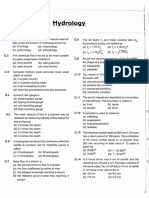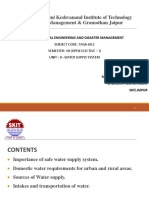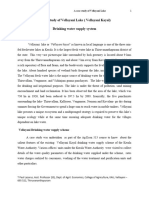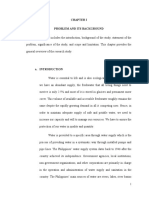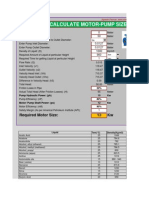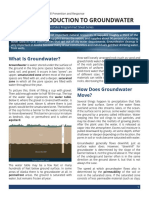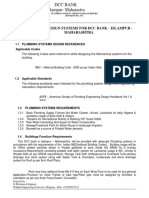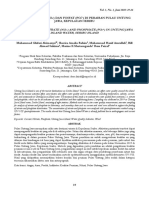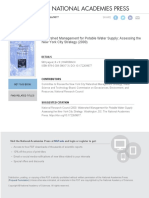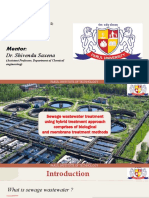Unit 3 Water Resources
Unit 3 Water Resources
Uploaded by
faizaCopyright:
Available Formats
Unit 3 Water Resources
Unit 3 Water Resources
Uploaded by
faizaCopyright
Available Formats
Share this document
Did you find this document useful?
Is this content inappropriate?
Copyright:
Available Formats
Unit 3 Water Resources
Unit 3 Water Resources
Uploaded by
faizaCopyright:
Available Formats
UNIT 3
WATER RESOURCES
The Indus provides the key water resources for the economy of Pakistan The River also supports many
heavy industries and provides the main supply of potable water in Pakistan.
The ultimate source of the Indus is in Tibet; The Indus then flow northwest through Ladakh and
Baltistan into Gilgit, just south of the Karakoram Range. The Shyok River and Gilgit streams carry
glacial waters into the main river. It gradually bends to the south, coming out of the hills between
Peshawar and Rawalpindi. It flows swiftly across Hazara, and is dammed at the Tarbela Reservoir. The
Kabul River joins it near Attock. The remainder of its route to the sea is in plains of the Punjab and
Sindh, and the river becomes slow-flowing and highly braided. It is joined by Panjnad River at Mithankot.
Passing by Jamshoro, it ends in a large delta to the east of Thatta.
We have world's largest and unified irrigation system that consists of three major reservoirs (Chashma,
Mangla, and Tarbela); 19 barrages (Ferozepur, Sulemanki, Islam, Balloki, Marala, Trimmu, Panjnad,
Kalabagh, Sukkur, Kotri, Taunsa, Guddu, Chashma, Mailsi, Balloki, Sidhnai, Rasul, Qadirabad, and Marala);
12 link canals; 45 irrigation canals.
Geography handouts prepared by USMAN HAMEED 03224557967 Page 1
Key Points:
Natural resources:
• Land, water, air.
• Natural resources can be described as renewable or nonrenewable resources.
(a) Renewable resources:
• RR can be recycled or reused.
• They can be used over and over again e.g. water, sunlight, wind power, tidal power, and geothermal
power.
• Sustainable e.g. vegetation, soil, landscape.
(b) Nonrenewable resources:
• NRR occur in limited quantity.
• If their use continues they will run out like fossil fuels and minerals.
Hydrological cycle:
• The water that reaches the ground from the atmosphere falls in various ways such as rain, snow or hail. This
is called precipitation.
• Some of the water runs directly off the earth’s surface as rivers and strems draining into lakes and the sea.
• The rest of the water is either utilized by plants or soaks into the ground.
• Water is returned to the atmosphere as water vapor through evaporation from surface water and by
transpiration from plants.
• Rising into the atmosphere the water vapor cools to form water droplets and this system is called
condensation.
• This cycle is called the hydrological cycle.
Geography handouts prepared by USMAN HAMEED 03224557967 Page 2
The Indus system:
• Indus is the largest river of Pakistan
• It is watered by the glaciers of the Karakorum and Hindu Kush. The source of river Indus is at the lake
Mansorowar at Tibet China.
• After crossing the Himalayas it turns into south west and enters Pakistan.
• After leaving the mountainous region of kalabagh the river enters the plains of Punjab and Sindh.
• Finally the Indus flows into Arabian Sea.
• The total journey of the Indus from source to mouth is about2900 km.
• On its way from source to mouth Indus is joined by some Eastern and Western tributaries.
• Eastern tributaries are Jhelum, Chenab, Ravi, Beas and Sutlej.
• Rising in the Himalayas and passing through Kashmir, the rivers enter the plains.
• The river Beas joins river Sutlej before entering into Pakistan.
• All the Eastern tributaries join at Panjnad and then flow for about a unified stream and join the Indus at
Mithankot after a distance of 72 km.
• The river Indus has the highest mean monthly discharge in June and July.
• Western rivers are Swat, Kabul, kurram, Tochi, Gomal, Zhob. These are smaller in length and width and have
less water than the eastern tributaries.
• The Indus basin covers an area of about one million square kilometers.
• The system irrigates about 60 % of Pakistan’s cultivatable land.
Baluchistan River System:
• Quetta being a high altitude region has the central position in the drainage pattern of Baluchistan.
• Rivers like Zhob, Khandar and the kalachi drain into river Indus because they flow eastwards.
• The rivers Loralai. Chakar, Bolan and Mula are absorbed into Kalachi Sibi Plain.
• The rivers Hab, Porali, Hingol and Mashkel drain into the Arabian Sea.
• There are many small rivers that flow westward and drain into shallow depressions called Humuns.
• There are so many rivers in Baluchistan those are absorbed in the land and do not join any other water body.
• This unique pattern of drainage is called Inland Drainage. Braided river channels are the depressions those
are flooded only when there is heavy rainfall and otherwise they remain dry.
Geography handouts prepared by USMAN HAMEED 03224557967 Page 3
• The Indus Waters Treaty is a water-distribution treaty between India and Pakistan, brokered by the World
Bank (then the International Bank for Reconstruction and Development). The treaty was signed in Karachi
on September 19, 1960 by Prime Minister of India Jawaharlal Nehru and President of Pakistan Ayub Khan.
• According to this agreement, control over the three "eastern" rivers — the Beas, the Ravi and the Sutlej —
was given to India, while control over the three "western" rivers — the Indus, the Chenab and the Jhelum —
to Pakistan.
• Tarbela Dam is an earth fill dam located on the Indus River in Pakistan. It is the largest earth-filled dam in
the world and fifth-largest by structural volume.
• The Mangla Dam is a multipurpose dam located on the Jhelum River in the Mirpur District of Azad Kashmir,
Pakistan. It is the 7th largest dam in the world.
• Warsak Dam is a mass concrete gravity dam located on the Kabul River approximately 20 km northwest of
the city of Peshawar in Khyber Pakhtunkhwa province of Pakistan.
• The Kalabagh Dam is a proposed hydroelectric dam on the Indus River at Kalabagh in the Mianwali District
of Punjab Province in Pakistan. Intensely debated, if constructed the dam would have 3,600 megawatts of
electricity generation capacity.
• Diamer-Bhasha Dam is a gravity dam, in the preliminary stages of construction, on the River Indus in Gilgit-
Baltistan, Pakistan.
• Khanpur Dam is a dam located on the Haro River near Potowar Plateau and the village of Khanpur, Khyber
Pakhtunkhwa, Pakistan, about 25 miles from Islamabad, Pakistan. And 15 km from Haripur.
• Baglihar Dam, also known as Baglihar Hydroelectric Power Project, is a run-of-the-river power project on the
Chenab River in the southern Doda district of the Indian state of Kashmir.
•
Compare the barrage shown in
Photograph B with the dam in
Photograph A.
Geography handouts prepared by USMAN HAMEED 03224557967 Page 4
Locate the two dams on the map:
• Warsak (W);
• Diamir Bhasha
Ground Water:
• The water available under the ground is called ground water.
• This water is brought to the ground by the method of lift irrigation by shallow wells, tube wells and the Karez
system
• GW can be sweet or saline. But it cannot be saline near the sources or recharge.
Methods of irrigation:
Traditional Methods:
(i) Shaduf:
A large pole balanced on a crossbeam, a rope and bucket on one end and a heavy counter weight at the
other. By pulling the rope it lowered the bucket into a canal or river. The operator would then raise the full
bucket of water by pushing down on the counter weight.
(ii) Well: A well is a hole dug in the ground to obtain the subsoil water. An ordinary well is about 3-5 meters
deep but deeper wells up-to 15 meters is also dug.
(iii) Inundation canals:
Inundated canals are long canals taken off from large rivers and it receives water when the river is high
enough and especially when it is in flood.
(iv) Charsa:
In charsa irrigation, animal power is used to pull out water from the well. In this the small area irrigates
and lots of time is waste in this system of irrigation.
Geography handouts prepared by USMAN HAMEED 03224557967 Page 5
.
(v) Persian Wheel:
Persian water wheel is a device used to raise water out of well or river. It is a system of a chain of buckets
slung round a vertical wheel, which is turned by a system of another interlocking vertical and horizontal
wheels powered by an ox or bull driven in a circle. With the passage of time the wooden wheel is replaced
by metal.
(vi) Karez:
(An underground irrigation channel), it is an underground structure for collecting groundwater and
conveying it to the surface. Such structures are in use in the mountainous and foothill areas. Water from a
karez is used for water supply and irrigation. Karez tunnels can be as much as several kilometres long.
Choose three terms from the list below and use them to label the diagram in three of the spaces provided.
Maintenance shaft aquifer canal tunnel water table
Modern methods:
(i) Perennial canals:
• They are linked to dams and barrages to provide water throughout the year and they irrigate a vast area.
Geography handouts prepared by USMAN HAMEED 03224557967 Page 6
(ii) Tubewells:
• Tubewells have diesel or electrically
operated pumps that can raise water from
the depth of 92 meters (300 feet) to irrigate
farms of more than 1000 hectares.
• Tubewells also help to lower the water table
thereby protecting the land from water
logging and salinity.
(iii) Sprinkler: water wastage.
• Sprinklers are connected to public water
supply pipes.
• They are centrally placed in fields to water
the plants.
• They are used mainly in orchards and market
gardening. It works efficiently with much less
Uses of water:
• Major uses of water are agriculture, domestic and industrial.
• 95 % of water is used for the irrigation purposes.
(a) Domestic uses:
• Drinking
• Cooking
• Washing
• Sanitation
(b) Industrial uses:
• Pharmaceutical industry
• Tanning industry(washing, dyeing)
• Food processing (juices, syrups)
• Chemical industry (acids, liquid bleach)
• Textile industry(washing, printing)
• Mineral water industry.
• Iron and steel industry.
• Thermal power stations( to produce steam that make the turbine move)
• Hydro – electric power stations.
(c) Irrigation
• Irrigation is an artificial supply of water.
Geography handouts prepared by USMAN HAMEED 03224557967 Page 7
• In Pakistan 75 % of the cultivated area is under irrigation.
• By canal irrigation millions of gallons of water are utilized that would flow into the Arabian Sea.
• Canal system irrigates a vast area. Even the deserts have been made productive.
• Irregular supply of water in the rivers is then regulated by construction of dams and barrages.
• Huge quantities of water from monsoon rainfall and melting of snow can be stored in reservoirs during
summer season.
Siltation in Reservoirs:
• The deposition of materials brought by the rivers in the reservoirs is called silt.
• This leads to the decrease in storage capacity of the reservoirs.
(i) Causes:
• Abundance of silt eroded from the Karakoram, Hindukush and Himalayan mountains.
• Deforestation
• Rivers from the narrow and deep valleys in the mountainous areas. Most of the eroded material is
washed down into the plains and piles in reservoirs of the dams.
(ii) Effects:
• Blockage of canals because silt accumulates.
• Weakens the foundation of dams.
• Choking of irrigation canals.
• Reduced capacity of reservoir and less flow of water affects the generation of Hydro electric power. it also
results in availability of less water for irrigation purposes.
• Flow of flood water is hampered which may cause heavy damage to the dam because of mounds of silt which
block the flow of water.
(iii) Control:
• Large scale afforestation especially on the foothills of the Himalayas.
• Cemented embankment of canals to make cleaning easier.
• Installation of silt trap before the water flows to the dams.
• Raising height of the dam to increase the capacity of the reservoir.
Types of Canals:
(i) Inundation Canals /seasonal canal
These canals provide water for irrigation only when there is high water table in the rivers.
(ii) Perennial Canals
These canals provide water for irrigation all year round.
(iii) unlined canals
The canals which do not have concrete or cemented embankments
Geography handouts prepared by USMAN HAMEED 03224557967 Page 8
(iv) lined canals
The canals having concrete embankments
Water logging and salinity:
• The condition when the water table of the ground rises is called water logging.
• When water level comes close to the ground.
• Salinity occurs when ground water rises and evaporates leaving the salt behind.
• Unlined perennial canals and the slow movements of water causes water logging and then salinity.
• This occurs when water from the unlined perennial canals penetrate into the ground causing water logging
and salinity.
Geography handouts prepared by USMAN HAMEED 03224557967 Page 9
Solution to water logging and salinity:
(i) Installation of tube wells.
• Tubewells are installed to solve the problem of water logging and salinity.
• Boring is done 100 meters below the ground using machines.
• Tubewells use electric pumps to lift the ground water.
• After the water is lifted, the water table of the ground goes down.
• Tubewells were used for the first time in 1953 and since then it has become the second largest
source of irrigation after canal irrigation.
(ii) planting of Eucalyptus tree
• It is the tendency of eucalyptus tree to be grown in waterlogged areas.
• It absorbs and utilizes the extra water present in the soil.
(iii) Lining of canals.
• Canals are lined from the banks to avoid absorption of water through the banks.
(iv) SCARP programme.
• Water logging can be controlled by the launching of the scarp (salinity control and reclamation project)
• It was framed in 1959 in which the Indus basin was divided into 28 zones.
• WAPDA was given the responsibility to carry out the project.
• Tube wells and surface drains were used to lower the water table and flush out salt from the soil
Geography handouts prepared by USMAN HAMEED 03224557967 Page 10
(i) Describe the distribution of soil erosion in Balochistan.
(ii) Where does eroded soil go to?
(iii) How can soil be protected in areas of low and unreliable rainfall?
Consider the feasibility of improving water supply to farmers in Punjab and Sindh. [6]
• In favour (res.1)
Rainfall in monsoon season can be stored/Snow melt from mountains/Indus river system brings water from
highlands/Can make more storage / reservoirs / dams / barrages/Can build more canals/Can use groundwater / build
more Tubewells
• Against (res. 1)
Cost of reservoirs, canals etc./Cost of Tubewells/Lack of reservoirs / dams / barrages/Indus Treaty limits supply / conflict
with India over supplies/Lower water table restricts groundwater/Waterlogging and salinity problems/Lack of / cost of
power supplies for pumps/Other constraints, e.g. education, wastage, conflict between users etc./Can be ruined by
floods
KAREZ
Geography handouts prepared by USMAN HAMEED 03224557967 Page 11
Geography handouts prepared by USMAN HAMEED 03224557967 Page 12
You might also like
- The Subtle Art of Not Giving a F*ck: A Counterintuitive Approach to Living a Good LifeFrom EverandThe Subtle Art of Not Giving a F*ck: A Counterintuitive Approach to Living a Good LifeRating: 4 out of 5 stars4/5 (5935)
- The Gifts of Imperfection: Let Go of Who You Think You're Supposed to Be and Embrace Who You AreFrom EverandThe Gifts of Imperfection: Let Go of Who You Think You're Supposed to Be and Embrace Who You AreRating: 4 out of 5 stars4/5 (1106)
- Never Split the Difference: Negotiating As If Your Life Depended On ItFrom EverandNever Split the Difference: Negotiating As If Your Life Depended On ItRating: 4.5 out of 5 stars4.5/5 (879)
- Grit: The Power of Passion and PerseveranceFrom EverandGrit: The Power of Passion and PerseveranceRating: 4 out of 5 stars4/5 (598)
- Hidden Figures: The American Dream and the Untold Story of the Black Women Mathematicians Who Helped Win the Space RaceFrom EverandHidden Figures: The American Dream and the Untold Story of the Black Women Mathematicians Who Helped Win the Space RaceRating: 4 out of 5 stars4/5 (925)
- Shoe Dog: A Memoir by the Creator of NikeFrom EverandShoe Dog: A Memoir by the Creator of NikeRating: 4.5 out of 5 stars4.5/5 (545)
- The Hard Thing About Hard Things: Building a Business When There Are No Easy AnswersFrom EverandThe Hard Thing About Hard Things: Building a Business When There Are No Easy AnswersRating: 4.5 out of 5 stars4.5/5 (353)
- Elon Musk: Tesla, SpaceX, and the Quest for a Fantastic FutureFrom EverandElon Musk: Tesla, SpaceX, and the Quest for a Fantastic FutureRating: 4.5 out of 5 stars4.5/5 (476)
- Her Body and Other Parties: StoriesFrom EverandHer Body and Other Parties: StoriesRating: 4 out of 5 stars4/5 (831)
- The Emperor of All Maladies: A Biography of CancerFrom EverandThe Emperor of All Maladies: A Biography of CancerRating: 4.5 out of 5 stars4.5/5 (274)
- The Little Book of Hygge: Danish Secrets to Happy LivingFrom EverandThe Little Book of Hygge: Danish Secrets to Happy LivingRating: 3.5 out of 5 stars3.5/5 (419)
- The World Is Flat 3.0: A Brief History of the Twenty-first CenturyFrom EverandThe World Is Flat 3.0: A Brief History of the Twenty-first CenturyRating: 3.5 out of 5 stars3.5/5 (2271)
- The Yellow House: A Memoir (2019 National Book Award Winner)From EverandThe Yellow House: A Memoir (2019 National Book Award Winner)Rating: 4 out of 5 stars4/5 (99)
- Devil in the Grove: Thurgood Marshall, the Groveland Boys, and the Dawn of a New AmericaFrom EverandDevil in the Grove: Thurgood Marshall, the Groveland Boys, and the Dawn of a New AmericaRating: 4.5 out of 5 stars4.5/5 (270)
- The Sympathizer: A Novel (Pulitzer Prize for Fiction)From EverandThe Sympathizer: A Novel (Pulitzer Prize for Fiction)Rating: 4.5 out of 5 stars4.5/5 (122)
- Team of Rivals: The Political Genius of Abraham LincolnFrom EverandTeam of Rivals: The Political Genius of Abraham LincolnRating: 4.5 out of 5 stars4.5/5 (235)
- A Heartbreaking Work Of Staggering Genius: A Memoir Based on a True StoryFrom EverandA Heartbreaking Work Of Staggering Genius: A Memoir Based on a True StoryRating: 3.5 out of 5 stars3.5/5 (232)
- Engineers Report - YclDocument3 pagesEngineers Report - YclAngela Emanuelle V. Estil90% (10)
- On Fire: The (Burning) Case for a Green New DealFrom EverandOn Fire: The (Burning) Case for a Green New DealRating: 4 out of 5 stars4/5 (75)
- PWWA Data Book 2017Document132 pagesPWWA Data Book 2017Von Amiel DimaculanganNo ratings yet
- The Unwinding: An Inner History of the New AmericaFrom EverandThe Unwinding: An Inner History of the New AmericaRating: 4 out of 5 stars4/5 (45)
- Canal IrrigationDocument38 pagesCanal Irrigationmhamzayasin20024No ratings yet
- Hydrology PDFDocument23 pagesHydrology PDFRahil LaskarNo ratings yet
- Reportsheet#7 - Determination of Dissolved Oxygen Content and Chloride in Water - Chem1103lDocument8 pagesReportsheet#7 - Determination of Dissolved Oxygen Content and Chloride in Water - Chem1103lMarielleCaindecNo ratings yet
- EEDM - Water Supply SystemDocument90 pagesEEDM - Water Supply SystemDivyanshu SharmaNo ratings yet
- 10102021103836SHS - EARTH SCIENCE - Q1 - M10 - Effects of Human Activities To Water ResourcesDocument18 pages10102021103836SHS - EARTH SCIENCE - Q1 - M10 - Effects of Human Activities To Water ResourcesJhon PerezNo ratings yet
- Vellayani Lake Water ReportDocument6 pagesVellayani Lake Water ReportAnandhu SNo ratings yet
- Quality of Bottled Water Brands in Egypt Part I: Physico-Chemical AnalysesDocument25 pagesQuality of Bottled Water Brands in Egypt Part I: Physico-Chemical AnalysesragiNo ratings yet
- Manitoba Flood Outlook Report - February 2023Document30 pagesManitoba Flood Outlook Report - February 2023ChrisDcaNo ratings yet
- Class IX: Chapter 3 - Drainage (Question & Answers) : Economic Benefits of RiversDocument3 pagesClass IX: Chapter 3 - Drainage (Question & Answers) : Economic Benefits of Riversatul ratan100% (2)
- Case Study HydrologyDocument16 pagesCase Study HydrologyJanine Micah MendozaNo ratings yet
- Kimyasal Yüklerin Denstyleri Ve Corr FactorsDocument5 pagesKimyasal Yüklerin Denstyleri Ve Corr FactorsNihat DğnNo ratings yet
- Problems of Drinking Water in Rural AreaDocument14 pagesProblems of Drinking Water in Rural AreaRoumyadeep ChakrabortyNo ratings yet
- D. Philippine Clean Water Act - 071719Document106 pagesD. Philippine Clean Water Act - 071719Angelika Calingasan100% (1)
- Aqua Cleer SLIM BU0191Document2 pagesAqua Cleer SLIM BU0191DANIEL GONZALEZ OLMO0% (1)
- 20 Pump Size CalculationsDocument20 pages20 Pump Size CalculationsNishant Gupta100% (2)
- TUNISIADocument20 pagesTUNISIAala garbeyNo ratings yet
- Philippine Clean Water Act of 2004Document7 pagesPhilippine Clean Water Act of 2004Joyce Lapuz100% (4)
- Groundwater AquifersDocument3 pagesGroundwater AquifersAkolbila EmmanuelNo ratings yet
- Plumbing DBR 30%Document5 pagesPlumbing DBR 30%Dolphin Engineering ServicesNo ratings yet
- 150 KLD Quotation Chouhan JiDocument8 pages150 KLD Quotation Chouhan JiTech Monger100% (1)
- 182-Article Text-633-1-10-20180411Document12 pages182-Article Text-633-1-10-20180411R MNo ratings yet
- 1 PBDocument8 pages1 PBTheo KenziNo ratings yet
- The National Academies Press: Watershed Management For Potable Water Supply: Assessing The New York City Strategy (2000)Document570 pagesThe National Academies Press: Watershed Management For Potable Water Supply: Assessing The New York City Strategy (2000)Vikesh RavichandrenNo ratings yet
- Rain Water Harvesting: CO5I-B Presented By: Jyoti Kolhe (73) Shubham Jadhav (74) Gaurav ThombareDocument21 pagesRain Water Harvesting: CO5I-B Presented By: Jyoti Kolhe (73) Shubham Jadhav (74) Gaurav Thombaresidhhart kunkololNo ratings yet
- Project PresentationDocument38 pagesProject PresentationThe AnonymousNo ratings yet
- HUI Service CatalogDocument12 pagesHUI Service CatalogSaefuddin SaefuddinNo ratings yet
- Hydro GeologicalbookletkabulprovinceDocument70 pagesHydro GeologicalbookletkabulprovinceMy Friend friendNo ratings yet
- Screenshot 2023-07-28 at 9.06.35 AMDocument11 pagesScreenshot 2023-07-28 at 9.06.35 AMAwonate AbokNo ratings yet












































